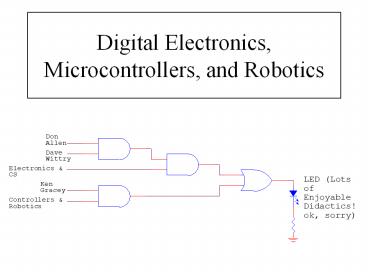Digital Electronics, Microcontrollers, and Robotics - PowerPoint PPT Presentation
Title:
Digital Electronics, Microcontrollers, and Robotics
Description:
BS2 sounded like fun and the means to my end took 2-day educator course from Parallax ... controlled system with Parallax's new Java-enabled microcontroller ... – PowerPoint PPT presentation
Number of Views:988
Avg rating:3.0/5.0
Title: Digital Electronics, Microcontrollers, and Robotics
1
Digital Electronics, Microcontrollers, and
Robotics
2
Outline
- Who
- Dave Wittry Don Allen (Troy), Ken Gracey
(Parallax) - Why
- show you enough fun things that you might want to
start/add to a class - Game plan
- ICT, Microcontroller Course, Parallax
- www.troyhigh.com/wittry
- all info today can be found here
- docs, this presentation, more (for
tests/quizzes, contact us)
3
ICT
- History of the development of the class.
- from general electronics to digital/computer
electronics - the infusion of ACSL-like topics
4
A bit - about - the bits that make up the class
5
Numbering Systems (1.5 weeks)
- conversions Baseany ? BaseanyOther
- addition/subtraction
6
Logic gates (3 weeks)
- AND, OR, NOT, NAND, NOR, XOR, XNOR
- wiring the labs
- breadboards, chips, leds (little exploding
devices) - lab sheets/assignments
- the lab itself
7
Karnaugh (K-Maps), NAND Implementations, Minterms
(2 weeks)
- method of simplifying boolean algebra expressions
8
Boolean Algebra (2 weeks)
- basic laws plus some specific only to boolean
values - DeMorgans Laws
9
DoorGoatWolf, AirLock, Football Projects
- ties all topics to this point together
- requirements
Project
10
Flip-Flops (2 weeks)
- RS, RS-clocked, D, J-K
- basic building block of shift-registers,
counters, memory devices - students find it cool that the same switch
combination can result in a different output
(output based on last outcome)
11
Counters (3 weeks)
- up, down, mod-N counters, using a 555-timer
12
Shift Registers (2 weeks)
- left, right, re-circulating
- multiplying/dividing by 2
- bit string flicking (ACSL)
13
Adders/Subtractors (3 weeks)
- ½ adders, full adders, ½ subtractor, full
subtractors - 1s and 2s Complement, integer math
- binary multiplication
14
Equipment costs
- Per group (2 students)
- breadboard, power supply (75)
- 20 chips (15)
- wires, template
- 6 LEDs (1)
- Class set
- logic probe (10), multi-meter (15)
- pliers, cutters, stripers, solder, solder-iron,
misc. (50)
15
Programming Microcontrollers Robotics
- History and Motivation for the class
- melding of hardware software
- freedom to experiment and have fun with practical
labs before it gets serious in college - BS2 sounded like fun and the means to my end
took 2-day educator course from Parallax - great if youre a newbie to controllers
- the curriculum is fun (WAM, BAD, IC, Robotics)
16
Programming Microcontrollers Robotics (contd)
- much harder to get physical, real-world projects
to do exactly what you want (neat!) as opposed to
a software (theoretical) class - theyll need time to experiment and try
algorithms - cool thing I learned right away watch out how
much you tell them theyre smarter/more
creative than you! Let them suggest lab ideas
and then try some.
17
Teaching Style Prerequisites
- if you plan on teaching this type of course using
a facilitative approach, keep prerequisites high - 20 students or so
- otherwise youre in for a nightmare with such an
independent, self-motivated type curriculum and
somewhat expensive hardware - great for middle-schools students as well
- this class is LOTS of fun to teach
18
The BS2 and How it Works
Code
Wiring
19
Interfacing to the real-world through a variety
of devices
- limited only by your imagination
- Types of devices you can interface to the
BasicStamp - almost anything!
- simple electronics stuff plus the more
advanced/fun things (sound module, RF
receiver/transmitter, video, web servermore from
Ken)
20
Electronics Component Companies
- http//www.stampsinclass.com (Parallax)
- http//www.elexp.com/ (Electronix Express)
- http//www.jameco.com/ (Jameco)
- http//www.kelvin.com/ (Kelvin)
- more easy to find on web
21
Robotics Labs
- great curriculum, well-written, nice springboard
to bigger better things, great for Back-To-School
night - usage of servos, usage of devices already
played with (potentiometer for direction
control, button for go/stop, etc.) (Francisco)
22
Robotics Labs (contd)
- line following (photo-resistors, TROY
sign-following - Maze labs (spend as much time as you want here
its where they have the most fun) - maze construction/development
- floor, walls, costs
- one-hallway maze
- find way in, report at end, find way out
- using whiskers
- using infrared devices
23
Robotics Labs (contd)
- algorithms learned/discovered (careful how much
you tell them) - follow-wall-right (quick bit on Karel)
- spin off idea (stay straight and follow wall)
- will be neat to try with Fuzzy Logic concepts
- bump-and-turn
24
Student-Designed Project
- provided you have a budget, let students go
through web sites, magazines/catalogs (Parallax,
Nuts-And-Volts, Robot Magazine, Mouser, etc.),
books and design a project. Limit them as to how
much they can spend. Have them prove they can
make it work - then buy materials and have them
go at it
25
Fuzzy Logic (optional topic)
- read a book in an engineering class? boy am I
mean! - Bart Koskos Fuzzy Thinking is a nice, friendly
place to start - current technology used in control systems to
give smoother, simpler control of complex systems - eventually implement a fuzzy-controlled system
with Parallaxs new Java-enabled microcontroller






























